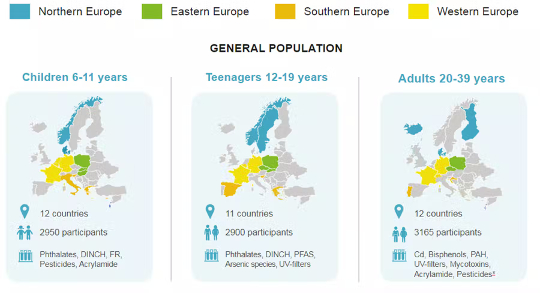
As the production of chemicals continues to boom, how exactly are they impacting our health? To answer this question, new tools have been developed to identify and monitor hazardous substances. Recent surveys have shown that 90% of Europeans are concerned about the impact of chemicals on the environment, while 84% worry about their potential risks to health.
Despite this, global chemical production is expected to double by 2030, reflecting a rapid increase in use in nearly every sector of the economy. The European Commission has also shelved its plans to tighten its restrictions on harmful substances - reforms to the so-called REACH legislation - to late 2023.
Awaiting this, current European law requires that chemicals employed in manufacturing processes be assessed for potential consumer risks before being placed on the market. Others present in the environment can also be harmful, whether they are of natural origin (eg. micro-organisms, toxin-producing fungi, soil metals, etc.) or synthetic (PCBs, chlordecone or metals).
By chemical, we refer to several substances mixed together to obtain specific properties for an intended product. They’re then categorised as cosmetics, paints, cleaning products, and so forth.
Assessing the damage
The modern era has increasingly exposed us to environmental pollutants. Whether it be in the air we breathe, the water or food we take in, the items we touch, or the products we apply to our skin, all go on to accumulate within our bodies.
This level of internal exposure then determines how seriously hazardous substances can affect us. But how can we measure it, amid the hundreds of thousands of chemicals that now pervade the planet? In the area of human health, the practice of biomonitoring shows some promise.
By measuring certain biomarkers added to blood, urine, hair, or breast milk samples, biomonitoring aims to measure the precise amount of chemical contaminants that our bodies can safely withstand. The science also has the advantage of taking into account individual differences related to physiology (for example, breathing, metabolism, and age) and behaviour (e.g., general hygiene and consumer product use).
Comparing previously incomparable European chemicals
With this in mind, European scientists have dedicated more than five of the past years to the HBM4EU initiative, a continent-wide project aiming to measure Europeans’ chemical exposure and its associated health risks. One of the priorities of this large-scale programme has been to build a network of efficient laboratories, and to standardise and monitor their analytical methods, such as in survey design.
In recent decades, human biomonitoring has been used as a tool in a wide array of research projects and national programmes, generating a vast quantity of data across Europe. However, this information is often fragmented and not easily comparable.
Recent technical and methodological progress has effectively multiplied the number of analysable chemical substances, but no standard reference method has been set up. Contrary to other fields, such as chemical food safety, there is currently no formal European framework for biomonitoring. A number of countries have set up national programmes in this domain, but each in isolation, limiting the potential for comparing results.
Set up as part of the HBM4EU project, our European network of 166 laboratories across 28 member states could fill this gap. Out of these laboratories, 74 have been certified for quality and comparability, 34 of which have gone on to complete more than 43,000 analyses.
Wanted chemicals list
To set out which chemicals to monitor, researchers prioritised substances on the basis of their toxicity, prevalence in humans or in the environment, and controversy among the public. Moreover, available knowledge about substances was also taken into account, with more-researched molecules likelier to generate quicker responses. This, in turn, helped to determine how the results could be used to improve substance management and, where appropriate, limit exposure.
In all, 24 countries have joined forces to gather data on their respective populations’ exposure to certain priority chemicals known for their negative health impacts, including cancerogenic, hormone and immune-disrupting effects. Key compounds measured were:
-
Phthalates and their substitute, DINCH. They’re used in the manufacture of plastics to make them soft and flexible, and in personal care products.
-
Per – and polyfluoroalkyl substances (PFASs), which are coveted for their non-stick, waterproof and heat-resistant properties.
-
Bisphenols, used to make clear, hard plastic.
-
Cadmium, used to protect critical components of aeroplanes and oil platforms.
-
Arsenic, which is found in pharmaceuticals, wood preservatives and agricultural chemicals. It also has applications in the mining, metallurgical, glassmaking, and semiconductor industries.
-
Acrylamide, present in contact lenses, permanent-press fabrics, toiletries, and soil stabilisers.
-
Sunscreens
-
Pesticides

Age groups monitored and chemicals researched in the Europe-wide studies. HBM4EU
Properly interpreting future results
Until now, scientists have determined safe exposure thresholds on the basis of chemical concentrations in foods or in the air. To find out whether the concentrations measured in blood or urine exceeded them, we had to set up safety thresholds, known as guidance values. Some 15 substances have been measured in the general or working population.
In the case of bisphenol S, there was a concentration of 1 µg per litre of urine among the general population and 3 µg per litre among workers. These concentrations vary because individuals coming in contact with bisphenol in their work are exposed through their skin, in addition to their (regular) diet, and across various scenarios. The figure here is calculated on the basis of their working time.
For other substances, the research went beyond simple determination of guidance values. For example, an estimate was made of the number of people in France, Spain, and Belgium at risk of osteoporosis due to heightened exposure to cadmium.
Workers are especially exposed
We attempted to monitor health in the workplace and refine our understanding of the hazards facing workers.
The programme has investigated exposure types specific to different sectors. For example, electronic waste management alone is exposed to carcinogens (eg. aniline and chromium VI) and sensitizers (eg. substances that sensitise the skin on first contact so that subsequent contact causes inflammation, such as diisocyanates). Our research will enable us to judge the efficiency of existing management methods or suggest new ones.
The HBM4EU project has helped develop new tools (surveys, participatory science, data analysis, etc.) for gathering the necessary data, which may lead to the establishment of recommendations for reducing the most hazardous exposure types.
Models correlating internal and external exposures have also been developed. All of this work could help identify primary sources of contamination to determine safety thresholds in the workplace.
Within five and a half years, the project has helped strengthen the network of European entities involved in biomonitoring or chemical risk assessment. This partnership will bring new data, methods, and tools to risk assessors and managers studying chemical hazards to human health. This will, in turn, help develop the scientific expertise required to tackle current and future challenges in chemical safety.
About The Author
Christophe Rousselle, European Project Manager, Agence nationale de sécurité sanitaire de l’alimentation, de l’environnement et du travail (Anses)
This article is republished from The Conversation under a Creative Commons license. Read the original article. Translated from the French by Enda Boorman for Fast ForWord.![]()
Related Books:
The Body Keeps the Score: Brain Mind and Body in the Healing of Trauma
by Bessel van der Kolk
This book explores the connections between trauma and physical and mental health, offering insights and strategies for healing and recovery.
Click for more info or to order
Breath: The New Science of a Lost Art
by James Nestor
This book explores the science and practice of breathing, offering insights and techniques for improving physical and mental health.
Click for more info or to order
The Plant Paradox: The Hidden Dangers in "Healthy" Foods That Cause Disease and Weight Gain
by Steven R. Gundry
This book explores the links between diet, health, and disease, offering insights and strategies for improving overall health and wellness.
Click for more info or to order
The Immunity Code: The New Paradigm for Real Health and Radical Anti-Aging
by Joel Greene
This book offers a new perspective on health and immunity, drawing on principles of epigenetics and offering insights and strategies for optimizing health and aging.
Click for more info or to order
The Complete Guide to Fasting: Heal Your Body Through Intermittent, Alternate-Day, and Extended Fasting
by Dr. Jason Fung and Jimmy Moore
This book explores the science and practice of fasting offering insights and strategies for improving overall health and wellness.























